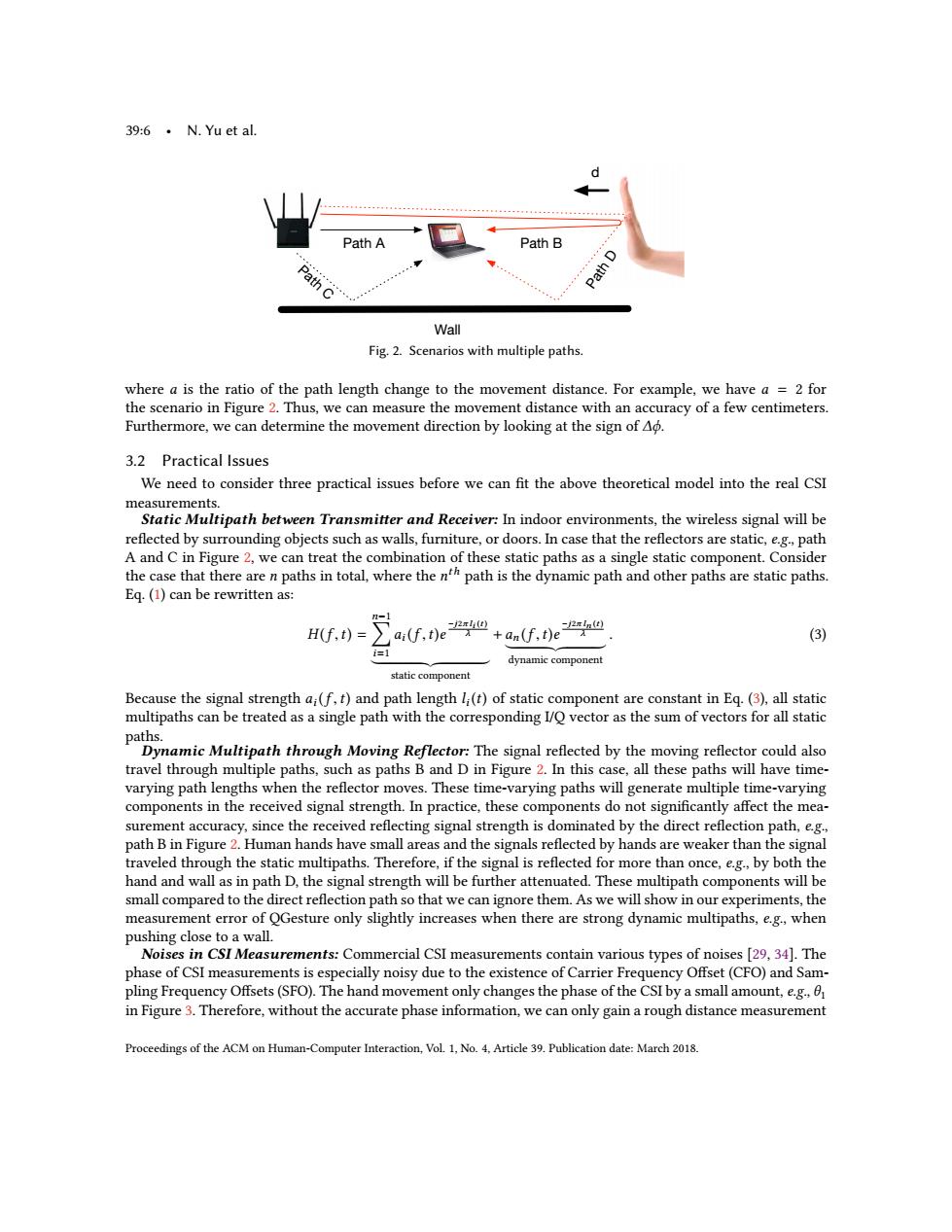正在加载图片...

39:6·N.Yu et al Path A Path B th 4 Wall Fig.2.Scenarios with multiple paths where a is the ratio of the path length change to the movement distance.For example,we have a =2 for the scenario in Figure 2.Thus,we can measure the movement distance with an accuracy of a few centimeters Furthermore,we can determine the movement direction by looking at the sign of Ad. 3.2 Practical Issues We need to consider three practical issues before we can fit the above theoretical model into the real CSI measurements. Static Multipath between Transmitter and Receiver:In indoor environments,the wireless signal will be reflected by surrounding objects such as walls,furniture,or doors.In case that the reflectors are static,e.g,path A and C in Figure 2,we can treat the combination of these static paths as a single static component.Consider the case that there are n paths in total,where the nth path is the dynamic path and other paths are static paths. Eq.(1)can be rewritten as: Hf,)-∑a,e0+f,e n-1 (3) i=1 dynamic component static component Because the signal strength ai(f,t)and path length li(t)of static component are constant in Eq.(3),all static multipaths can be treated as a single path with the corresponding I/Q vector as the sum of vectors for all static paths. Dynamic Multipath through Moving Reflector:The signal reflected by the moving reflector could also travel through multiple paths,such as paths B and D in Figure 2.In this case,all these paths will have time- varying path lengths when the reflector moves.These time-varying paths will generate multiple time-varying components in the received signal strength.In practice,these components do not significantly affect the mea- surement accuracy,since the received reflecting signal strength is dominated by the direct reflection path,e.g, path B in Figure 2.Human hands have small areas and the signals reflected by hands are weaker than the signal traveled through the static multipaths.Therefore,if the signal is reflected for more than once,e.g.,by both the hand and wall as in path D,the signal strength will be further attenuated.These multipath components will be small compared to the direct reflection path so that we can ignore them.As we will show in our experiments,the measurement error of QGesture only slightly increases when there are strong dynamic multipaths,e.g.,when pushing close to a wall. Noises in CSI Measurements:Commercial CSI measurements contain various types of noises [29,34].The phase of CSI measurements is especially noisy due to the existence of Carrier Frequency Offset(CFO)and Sam- pling Frequency Offsets(SFO).The hand movement only changes the phase of the CSI by a small amount,e.g, in Figure 3.Therefore,without the accurate phase information,we can only gain a rough distance measurement Proceedings of the ACM on Human-Computer Interaction,Vol.1,No.4,Article 39.Publication date:March 2018.39:6 • N. Yu et al. Path A Path B Wall Path C Path D d Fig. 2. Scenarios with multiple paths. where a is the ratio of the path length change to the movement distance. For example, we have a = 2 for the scenario in Figure 2. Thus, we can measure the movement distance with an accuracy of a few centimeters. Furthermore, we can determine the movement direction by looking at the sign of ∆φ. 3.2 Practical Issues We need to consider three practical issues before we can fit the above theoretical model into the real CSI measurements. Static Multipath between Transmitter and Receiver: In indoor environments, the wireless signal will be reflected by surrounding objects such as walls, furniture, or doors. In case that the reflectors are static, e.g., path A and C in Figure 2, we can treat the combination of these static paths as a single static component. Consider the case that there are n paths in total, where the n th path is the dynamic path and other paths are static paths. Eq. (1) can be rewritten as: H(f ,t) = ∑n−1 i=1 ai (f ,t)e −j2πli (t ) λ | {z } static component +an (f ,t)e −j2πln (t ) λ | {z } dynamic component . (3) Because the signal strength ai (f ,t) and path length li (t) of static component are constant in Eq. (3), all static multipaths can be treated as a single path with the corresponding I/Q vector as the sum of vectors for all static paths. Dynamic Multipath through Moving Reflector: The signal reflected by the moving reflector could also travel through multiple paths, such as paths B and D in Figure 2. In this case, all these paths will have timevarying path lengths when the reflector moves. These time-varying paths will generate multiple time-varying components in the received signal strength. In practice, these components do not significantly affect the measurement accuracy, since the received reflecting signal strength is dominated by the direct reflection path, e.g., path B in Figure 2. Human hands have small areas and the signals reflected by hands are weaker than the signal traveled through the static multipaths. Therefore, if the signal is reflected for more than once, e.g., by both the hand and wall as in path D, the signal strength will be further attenuated. These multipath components will be small compared to the direct reflection path so that we can ignore them. As we will show in our experiments, the measurement error of QGesture only slightly increases when there are strong dynamic multipaths, e.g., when pushing close to a wall. Noises in CSI Measurements: Commercial CSI measurements contain various types of noises [29, 34]. The phase of CSI measurements is especially noisy due to the existence of Carrier Frequency Offset (CFO) and Sampling Frequency Offsets (SFO). The hand movement only changes the phase of the CSI by a small amount, e.g., θ1 in Figure 3. Therefore, without the accurate phase information, we can only gain a rough distance measurement Proceedings of the ACM on Human-Computer Interaction, Vol. 1, No. 4, Article 39. Publication date: March 2018